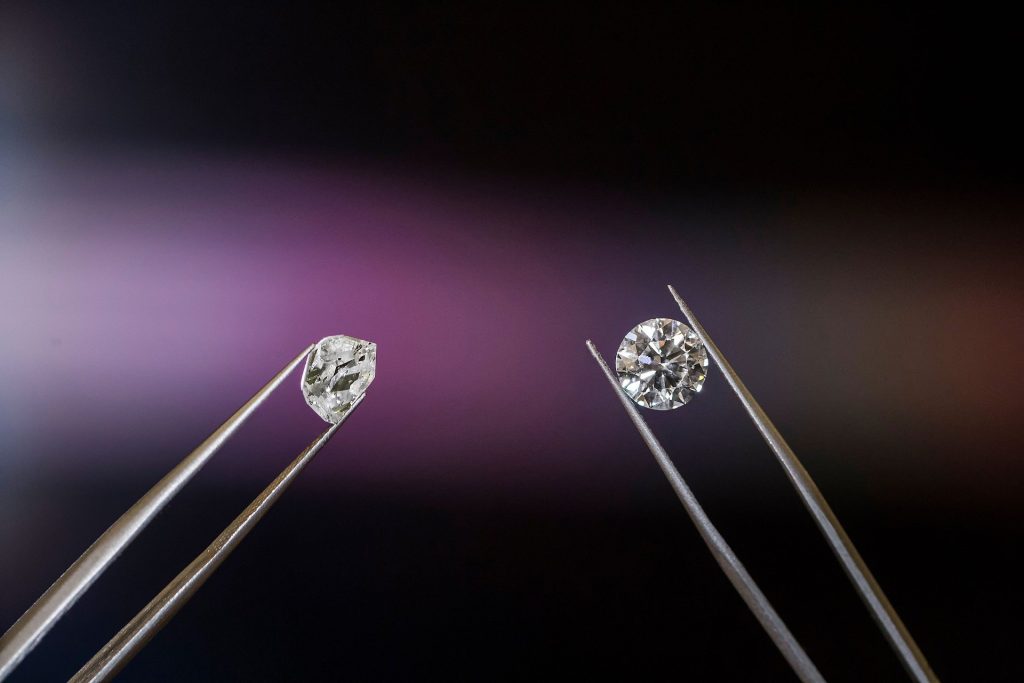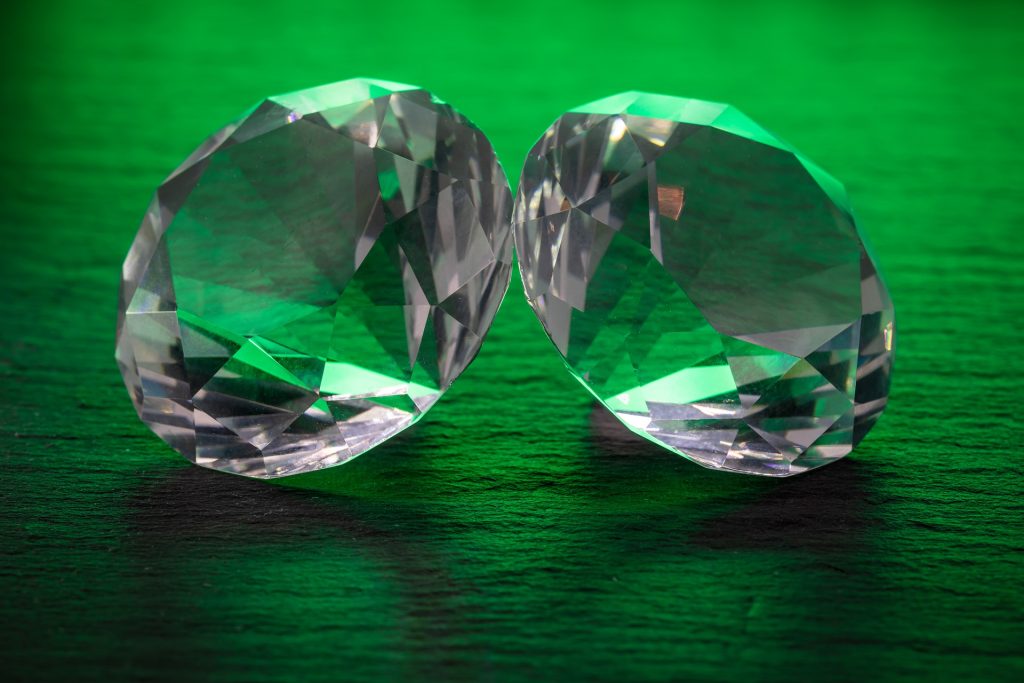The terms simulated diamond and “simulant” are both overly broad and often confusing, but there are some fundamental differences between the two gemstones. Lab-grown diamonds are a type of simulated diamond. Cubic zirconia and moissanite are two examples of laboratory-created gemstones. They are not the same thing. The difference between these two types of stones is the clarity level.
Those beautiful, shiny, shiny diamonds that you envy may not be real diamonds. You’d be surprised how many “diamonds” you find at your local jewelry store are lab-grown diamonds or rhinestones like moissanite.

What is Moissanite, & How is it Different From Other Artificial Diamonds?
Learn everything you need to know about moissanite and how it is used to imitate real diamonds. Find out what makes a lab-grown gemstone different from a simulated diamond. And, discover what makes a diamond sparkle
Difference Between Real & Simulated Diamond
Simulated diamonds are not real diamonds, and they are not as expensive as natural diamonds. They are much cheaper than natural stones, and are an excellent substitute for everyday use. As an additional bonus, moissanite is much more affordable than a real diamond. While their prices vary, they are generally priced well below real diamonds. They can also be customized to reflect a person’s personality.
When comparing diamonds, it’s best to remember that moissanite is an imitation of a natural stone. While it is often made into jewelry, real diamonds are more expensive than moissanite. So, it’s important to remember that the difference between a natural diamond and a synthetic diamond is the clarity level. The quality of the diamond should be determined from the cut of the stone.
What is Moissanite?
When you buy bridal diamonds from a local jeweler, you will find that many bridal stones are not diamonds. You’ve probably seen the term “moasanite” before. You might be wondering what moasanite is. Moissanite is a great alternative because it looks so much like real diamonds. The material is silicon carbide, which mimics the same properties as natural diamond. Unlike lab-grown diamonds, moasanite and many polymorphic crystals are naturally occurring, so moasanite is an imitation of diamonds.
While diamonds are a rare and expensive gemstone, simulants are more affordable than their real counterparts. A lab-grown moissanite is more likely to look like a real diamond and is therefore the perfect diamond alternative. A beautiful and durable alternative, moissanite also comes with an added benefit: it’s customizable and less expensive than diamonds. You can even make your own ring or create your own with a simulated one.
What is Imitation Diamond?
Artificial diamonds are created to mimic the same visual properties as natural diamonds. Examples of model diamonds include moasanite, white topaz and cubic zirconia. Although rhinestones embody the brilliance and other qualities of real diamonds, their molecular and chemical properties are quite different.
A simulated diamond is a man-made diamond with a simulated diamond’s crystal structure. This man-made gem is not the same as a real diamond. It’s made up of various different materials. Consequently, it’s more expensive than a natural diamond. A simulated diamond has the same quality and weight as a real diamond. Its optical properties are the same as a natural one, but the two are different.
A simulated diamond is a synthetic diamond with a coating of a real diamond. It is much cheaper than a natural diamond, and is the perfect alternative for everyday wear. The main benefit of a simulated ring is that it is customized. In addition to being a simulated diamond, a simulated moissanite is a man-made gemstone, and it is not diamond.
Appearance: Less brilliant than mined diamonds and typically colorless. Generally reflects blue and orange flashes or a ‘disco ball’ appearance, as opposed to the whole rainbow.
Cost: This will depend on the simulant. A 1 carat cubic zirconia, for example, can be purchased for under $50. A 1 carat moissanite, on the other hand, would cost a bit over $500.
Composition: The most popular diamond simulants are made from Zirconium Dioxide (cubic zirconia), Silicone Carbide (moissanite), or white sapphire.
Diamond Labs vs. Diamond Simulation
Lab-grown diamonds, also known as synthetic diamonds, are diamonds that have been grown, processed, or made in a laboratory and are chemically indistinguishable from “real” diamonds. Lab diamonds are grown under controlled laboratory conditions, not in the Earth’s mantle. Developed in a laboratory using advanced technological processes, diamonds undergo a highly accelerated process that mimics natural geological conditions over time.
The difference between a simulated diamond and a moissanite is that a simulated diamond has a lower cost than a natural diamond, but the two are not the same. A simulated diamond is made in a lab and appears to be perfectly flawless. It is similar to a real diamond, but is made with a lower-quality material. It is much cheaper than a real diamond and is less durable.
What is the Real Diamond?
If lab diamonds are structurally and optically identical to “real” diamonds – what is a “real” diamond? Engineered diamonds are real diamonds, but the difference lies in where the diamond comes from. The most expensive and rare type of diamond is earth-mined.
An earth-mined diamond is the only type of diamond to exist, until the 20th century. Simulant diamonds are the first alternative to appear. And, synthetic diamonds are a marvel of technology, as recently as 1955.
How Much Does Moissanite Cost?
In terms of price, artificial diamonds are the cheapest option. Diamonds mined from the ground have the highest prices, while synthetic diamonds are priced somewhere in between. However, man-made diamonds are farther away from synthetic diamonds on the price scale than synthetic diamond prices.
Why Call It Something It’s Not?
Of course, it’s terribly misleading to call stones simulated diamonds when they aren’t diamonds at all. But the term “fake diamond” probably wouldn’t go over well with consumers. For its part, the Federal Trade Commission has at least ruled it an unfair and deceptive practice to use the term synthetic for stones that are not the real deal. Yet that practice persists, particularly online, so buyer beware.
Synthetic or lab-grown diamonds are rated on the same grading scale as earth-mined diamonds. Lab diamonds are graded on a scale that extends higher than that of earth-mined. Moissanite and other simulant diamonds are manufactured to feature the same geometric cuts as real diamonds. And, even though moissanite is naturally occurring, it is very rare in nature. So, the moissanite used in jewelry is often created through a manufacturing process.
This lends to simulant diamonds being much more affordable than synthetic diamonds. Simulated diamonds are the perfect alternative to real diamonds because of, either, budgetary restrictions, and they are better for regular use. You get all the aesthetic and glamour of wearing a beautiful diamond, without the risk associated with a real diamond.
How to Clean Simulated Diamond Rings & Jewelry?
Cleaning simulated diamonds can be tricky, especially for the softer gemstones, and stones that react to light and other chemicals.
Diamonds and Moissanites can be cleaned professionally by your trusted jeweler. The same goes for other precious stones such as sapphires and morganites. However, Cubic Zirconia jewelry is relatively cheap and can be cleaned using running water and gentle soap.
Another important distinction between a simulated diamond and a moissanite is their color. The former has a higher refractive index, while the latter is more translucent. In natural light, a simulated diamond has a darker hue. However, a simulated diamond will not scratch. It will not show a natural diamond’s color. The simulated diamond will appear white, but will have a yellow or brown tint.
Why Buy a Simulated Diamond?
Buying a synthetic diamond is not always about saving money. Although, the difference in price might get you that vacation you have been wanting to go on. Primarily consumers buy such diamonds to increase their mindfulness.
These synthetic diamonds are purchased for ethical reasons. Mining for raw diamonds leads to environmental impacts. So to boost sustainable sourcing of raw materials, a lab-grown diamond or a synthetic diamond is a preferred choice. It also does not burden the conscience of the consumer in any such way.
It is a good idea to buy simulants for anniversaries, small celebrations or any such event. It keeps things easy on your wallet. Cheap or not, it is important to buy a synthetic or real diamond from a trusted seller.
Conclusion
A simulated diamond has a lower refractive index than a natural diamond. Moreover, a simulated diamond will not scratch easily, unlike a real one. A simulated diamond does not scratch. A simulated stone will scratch with greater ease. A simulated stone can be more durable than a natural diamond, which means it will last longer. Besides looking more like a real gemstone, a simulated diamond is not very expensive. It costs less than a similar diamond.
If you are looking for an earth-mined diamond, a simulated diamond will look more genuine and durable. But the simulated diamond is an imitation and may not be as strong as a real diamond. Because it is made by a man, it is a much better choice for a ring than a real one. And it is eco-friendly, unlike a real diamond.







